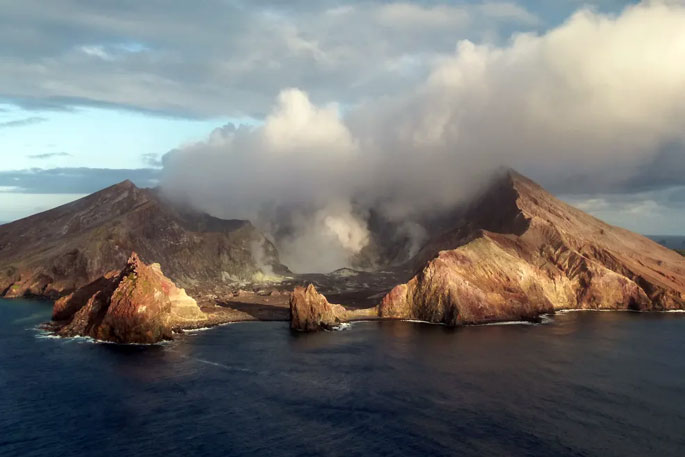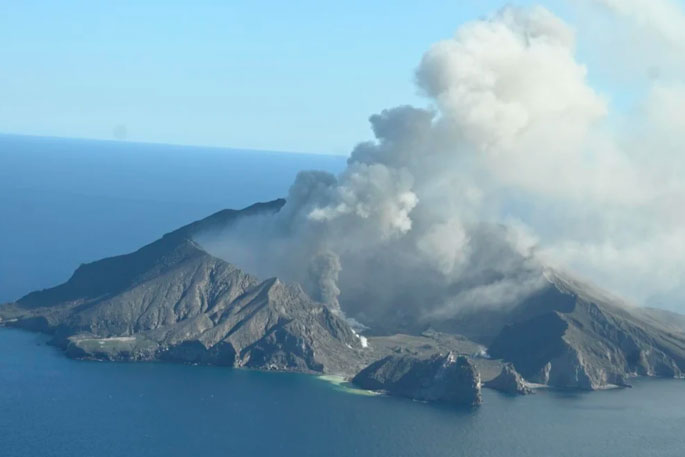Ongoing volcanic activity on Whakaari/White Island led to flight disruptions on Thursday morning.
So what exactly is going on at the island, which has a deadly history, and should it worry us on the mainland?
RNZ has all you need to know.
Latest situation
Bay of Plenty Emergency Management said Whakaari/White Island is going through an extended active period.
The Volcanic Alert Level was raised to Level 3 and the Aviation Colour Code raised to orange on August 9.
Lisa Glass, duty public information manager for Bay of Plenty Emergency Management, tells RNZ nothing particularly different is occurring with the volcano.
What has changed is the wind direction - MetService says it changed overnight, pushing some Whakaari/White Island atmospheric ash towards the mainland.
GNS Science indicated that ash fall is only occurring near the island and Glass says it's incredibly unlikely that ash would reach the mainland.
MetService is responsible for issuing Volcanic Ash Advisories for the aviation sector (a collaboration with GNS Science and Airways New Zealand).
Its latest advisory showed volcanic ash was drifting over eastern Bay of Plenty today, leading Air New Zealand to cancel and delay flights. Air New Zealand told RNZ it did so as a proactive safety measure.
Should we be concerned?
Dr Simon Barker, Rutherford discovery fellow and senior researcher at Victoria University of Wellington, thinks the biggest issue with Whakaari/White Island at the moment is the number of unknowns.
There is a lack of monitoring on the island due to the 2019 eruption and restricted access preventing the repair of seismic and geodetic networks.
"This makes it difficult to place the ongoing activity within the context of past eruptive episodes and to assess how the system is changing. Gas flights, drone footage and ash emissions all suggest that magma is very close to the surface and therefore this activity could continue for some time."
Barker says the country should re-establish monitoring and ongoing research on the island.
 Photo: Supplied/ University of Canterbury.
Photo: Supplied/ University of Canterbury.
What actually is ash?
Dr Adrian Pittari, senior lecturer of earth sciences at University of Waikato, explains that volcanic ash is "the fine 'dusty' volcanic glass and rock particles carried within eruption plumes, that rise into the atmosphere and then downwind by air currents".
He says ash in volcanic plumes is considered a hazard to aeroplanes flying in affected airspace because it is sucked into their engines potentially clogging fuel lines, sticking onto engine surfaces and eroding parts.
"It can also interfere with electrical and computer systems, infiltrate cabin space and reduce visibility."
Barker agrees and says that flights had been cancelled as a standard precaution with changing wind directions and ash particles in the atmosphere around this region.
Ash is only falling to the ground/sea surface close to Whakaari/White Island and has not fallen on the ground near the Bay of Plenty coast.
"However it is the high airborne ash in the vicinity of flight paths that is the main concern to airlines," says Adrian.
When will it all end?
Dr Shane Cronin, professor of volcanology at the University of Auckland, says this level of activity is likely to remain "annoying" for a while if this magnitude of eruption continues.
"By annoying, I mean that the semi-regular puffs of steam and gas cause unease as well as justified precautionary reactions by the aviation community. The ash content of the plume is generally low and this is of low hazard to people - the threat to aircraft is well known and precautions are well advised. Variations in wind will mean that sometimes the plume may reach the mainland," says Shane.
Like Simon, Shane is concerned about the lack of a seismic station on the island. But Shane goes further with his criticism.
"We are in this crazy situation with a community of scientists that have built up world-class volcanic science knowledge and an array of skills including machine-learning techniques for automated forecasting but no way of using them at present for this volcano, because a mess of convoluted legal red tape is stopping GNS Science from being able to re-install the seismic stations."



2 comments
Can't see White island
Posted on 23-08-2024 11:32 | By RJW
Covered in dark smoke
what is safer...
Posted on 23-08-2024 19:16 | By OG-2024
Is it safer to ALLOW - not send but allow, a team to go to the island fully informed and aware, when THEY believe it is safe enough to do so to reset the monitoring that is possible to restore SAFELY.....and maybe be forewarned of dangerous changes....
OR
Allow red tape to prevent any attempts and not know WHAT is going on in/ on/ around the island ????
What happens IF it does erupt leading to loss of life and it's found later that it would have been possible to restore some monitoring that could have given life saving warning??
Leave a Comment
You must be logged in to make a comment.